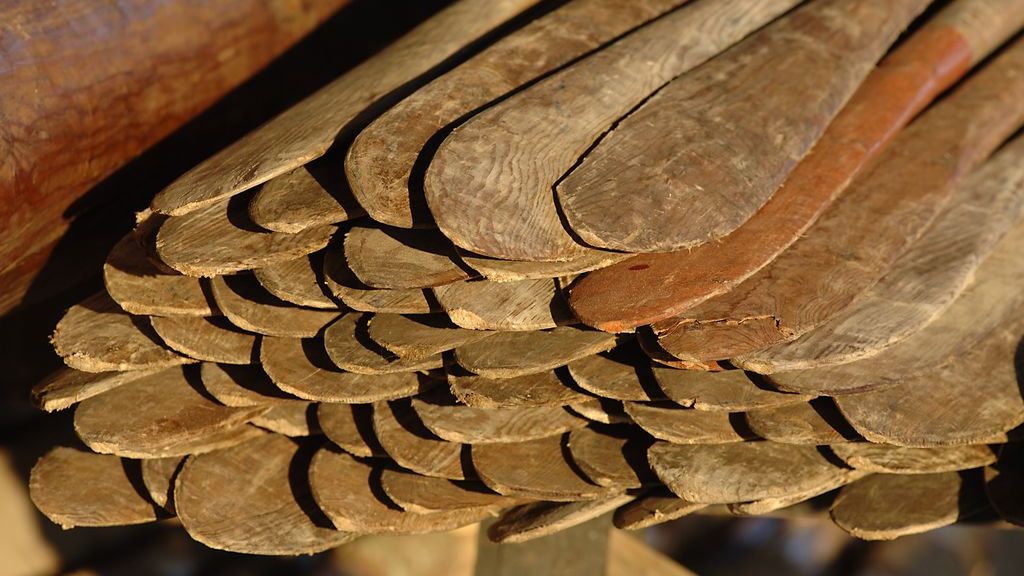During the first half of the 19th century, a large number of oak trees were planted with the intention of providing timber for the naval fleet, giving rise to the colloquial term ‘fleet oak’. Back then, no-one could have known that metal would render wood redundant as a ship-building material, and the majority of the old trees have therefore been left standing.
Now, two of the fleet oaks from Jægersborg Hegn will be felled to fulfil their original purpose.
After the loss of the Danish fleet in 1807, drastic measures had to be taken to address the lack of suitable oak for ship-building. At the order of the king, the Admiralty began the extensive planting of new oaks, so that future generations would be ensured a good supply of materials. Today, we know that this decision was made irrelevant when iron ships took over. The situation has, in more recent times, given rise to many urban myths about foresters giving notice that their trees were now ready to be felled.
The boatbuilders from the Viking Ship Museum have been granted permission to fell two of these so-called fleet oaks from the state-owned forest at Jægersborg Hegn. The mature oak trees will be used in the construction of a full-scale Viking ship. The ship is a reconstruction of one of the original Viking ships, which were found near Skuldelev on Roskilde Fjord, over fifty years ago. <s></s>
The two trees have been carefully selected on the basis of their shape and form, so that they match the level of quality the Vikings would also have sought, when building their ships 1000 years ago:
“Finding suitable trees to use is not an easy task for us”, says Søren Nielsen, Leader for Maritime Craftwork at the Viking Ship Museum. “This is partly because the current forested area is much smaller than in the Viking Age and partly because the majority of oaks are felled before they reach the 90-100 cm diameter that we need”. Therefore, it’s seldom that you can find suitable oaks that can be used to build a ship using Viking Age technology, where planks must be cleaved out and hewn with axes, as opposed to the modern technique, where they are sawn. “So it’s a fantastic situation for us, when Naturstyrelsen, Vallø Stift and others can find these oaks and make it possible to use fleet oak as it was originally intended, as first-class ship-building material”.
The ship, which will be built at the Viking Ship Museum, is a reconstruction of the ship-find, Skuldelev 3, a small trading ship from ca 1040. “When we use the word reconstruction rather than copy, it’s because it’s a more accurate term”, emphasises Søren Nielsen. “A copy requires that you have 100% of the original ship as a source, and even though we have 75% of the ship Skuldelev 3, it still requires an element of interpretation. We have previously built a reconstruction of Skuldelev 3 – Roar Ege from 1984 – which was actually the first Viking ship built at the Viking Ship Museum. It’s now worn out as a sailing ship but the knowledge and experience we have gained from building and sailing with this ship will form the basis for the new ship we’ll build over the next three years. In this way, maritime cultural heritage is preserved and given further to future generations, both in a tangible ship but also as an embodiment of intangible heritage, where craft work and knowledge about Viking Age boatbuilding methods are kept alive.”
Info:
The ship-find, Skuldelev 3, was excavated in 1962, near Skuldelev on Roskilde Fjord.
Skuldelev 3 was found together with four other Viking ships – the so-called Skuldelev ships – all of which are exhibited at the Viking Ship Museum in Roskilde.
The five Viking ships are dated to the later part of the Viking Age, ca 1040.
During the Viking Age, the Skuldelev ships were scuttled across a sailing channel on the way to the important trading town at Roskilde, as a defence against seaborne enemies.
From 1982-1984, the Viking Ship Museum built a reconstruction of Skuldelev 3, Roar Ege, but after more than 30 years on the water, it’s no longer seaworthy.
During the last 30 years, the Viking Ship Museum has built reconstructions of all five of the Skuldelev ships. These reconstructions can be seen at the Viking Ship Museum – when they’re not out on a voyage!
The construction of the new reconstruction has already begun at the Viking Ship Museum and can be followed over the next three years up to the launch in 2019, where the Viking Ship Museum will celebrate its 50th anniversary.



